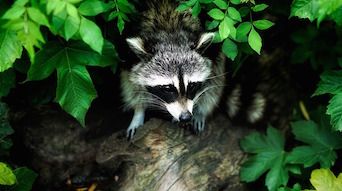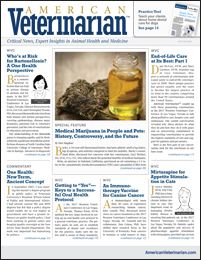Recent Research Highlights Infectious Potential of Baylisascaris procyonis
High worm fecundity and the potential for severe pathology in humans and other hosts make raccoon roundworm a double threat.

The raccoon roundworm Baylisascaris procyonis can cause severe disease in people who accidentally ingest the eggs. Articles published recently in the Journal of Parasitology describe the prevalence of Baylisascaris in California raccoons and the viability of eggs in south Texas soil.
In these 2 studies, 80% of the raccoon population carried adult Baylisascaris, and eggs remained viable at or near the soil surface for at least 2 years. The authors of both studies note the exposure risk to humans and other host species reflected in these results.
Raccoons, the definitive host of B. procyonis, are usually not clinically affected by the parasite. Small animals (particularly rodents, rabbits, and birds) that ingest eggs passed in raccoon feces can show signs of clinical illness. Dogs that eat infected small animals may become definitive hosts and shed eggs.
Humans become infected from exposure to environments frequented by raccoons. Human infection is uncommon in the United States. Fewer than 25 cases are known to have occurred, according to the Centers for Disease Control and Prevention. However, infection can lead to neural and visceral larval migrans, with symptoms ranging from nausea to death (6 patients have died).1
Baylisascaris In California Raccoons
Sara Weinstein, a graduate student in the Department of Ecology, Evolution, and Marine Biology at the University of California, Santa Barbara, examined the intestinal tracts of 189 raccoons collected by trappers or found as roadkill in Santa Barbara County from 2012 to 2015.
Adult roundworms were present in 152 of 189 raccoons (80.4%), with each infected raccoon carrying between 1 and 125 adult worms. Including immature roundworms in the count increased the prevalence to 183 of 189 raccoons (90.7%); most infected raccoons hosted up to 200 immature worms. Ms. Weinstein noted that one outlier carried more than 2000 immature roundworms.
Roundworm abundance was higher in juveniles (under 1 year old) than in adults. All the raccoons 4 to 7 months of age harbored at least 1 adult roundworm, and Baylisascaris was present in raccoons as young as 10 weeks. Most (68%) of the sampled raccoon population was younger than 1 year of age. Ms. Weinstein attributed the age difference in infection to the increased susceptibility of young raccoons.
Roundworm abundance peaked in the fall and winter seasons, reflecting the proportion of juveniles in the population, said Ms. Weinstein (raccoons born in the spring carry a high worm burden by the fall). She noted that in colder climates, Baylisascaris abundance tends to peak in the fall and drop during the winter.
“High worm fecundity, and the potential to cause severe pathology in humans and other hosts, makes raccoon roundworm a threat to human and wildlife health,” concluded Ms. Weinstein. Because juveniles represent the greatest risk for disease transmission, she suggests that management strate- gies focus on young raccoons.2
Viability of Eggs In Texas Soil
Investigators from the Caesar Kleberg Wildlife Research Institute at Texas A&M University studied the effects of soil condition on B. procyonis egg permeability and viability. They wrote, “A major objective of our work was to analyze the fate of B. procyonis eggs in south Texas soils: Do eggs move from the surface down into the soil? And if so, how long does this take? And is this movement affected by soil texture and moisture?”
The researchers distributed B. procyonis eggs onto grids containing 4 soil types (sand, silt, clay, or loam) with 2 sun exposures (shaded or full sun) and 2 moisture levels (wet or dry). For 2 years, they counted eggs in randomly selected soil samples and estimated egg viability by assessing the fraction of motile larvae.
Eggs percolated through wet soils faster than through dry soils. Sun exposure had no effect on egg movement. The most permeable soil type was wet sand, in which about 23% of eggs remained at the surface after 2 years. In contrast, 100% of the eggs in dry clay soil remained at the surface after 2 years. In wet sand, 23.1% of eggs percolated to 6 to 10 cm, the greatest depth measured. The authors pointed out that even at this depth, eggs are still accessible to potential host animals.
Egg viability was unaffected by soil type, moisture, sun exposure, soil depth, or time. For all soil types and environmental conditions, 92% to 100% of eggs remained viable at the end of the 2-year study period. Given the climate in south Texas, wrote the authors, this result highlights the “extreme persistence of B. procyonis eggs.”
“Based on our findings,” concluded the authors, “high exposure probabilities exist for intermediate, definitive, and dead-end hosts in areas where B. procyonis—infected raccoons are endemic within southern Texas.” They recommended that veterinarians, physicians, and people working with wildlife should be aware of B. procyonis risk and take appropriate precautions when working in environments where raccoons gather.3
Dr. Laurie Anne Walden received her doctorate in veterinary medicine from North Carolina State University in 1994. After an internship at Auburn University College of Veterinary Medicine, she returned to North Carolina, where she has been in companion animal general practice for over 20 years. Dr. Walden is also a board-certified editor in the life sciences and owner of Walden Medical Writing.
References:
- Parasites — Baylisascaris infection. Centers for Disease Control and Prevention website. https://www.cdc.gov/parasites/baylisascaris/. Updated May 24, 2016. Accessed March 13, 2017.
- Weinstein SB. Baylisascaris procyonis demography and egg production in a California raccoon population. J Parasitol. 2016;102(6):622-628.
- Ogdee JL, Henke SE, Wester DB, Fedynich AM. Permeability and viability of Baylisascaris procyonis eggs in southern Texas soils. J Parasitol. 2016;102(6):608-612.
